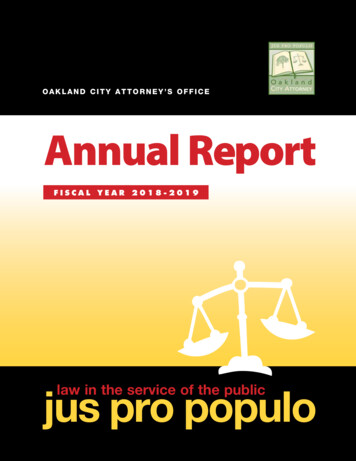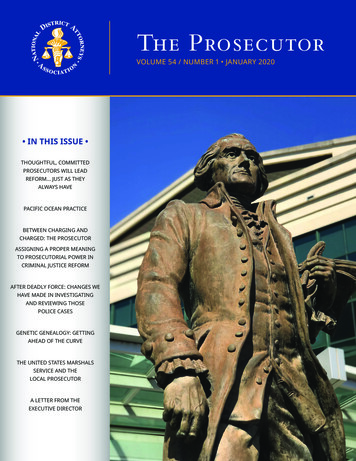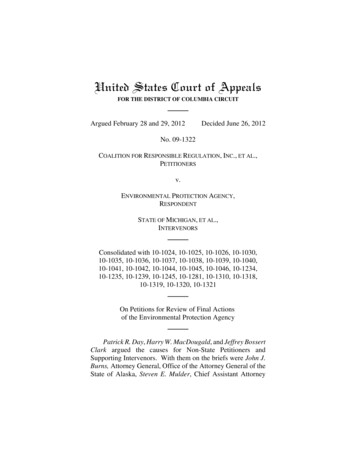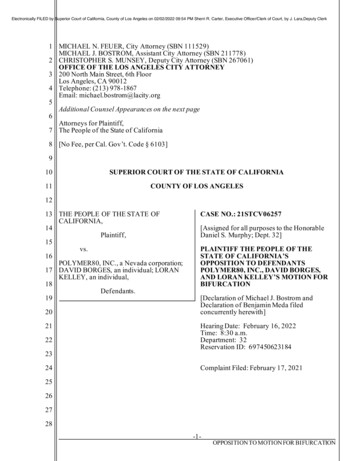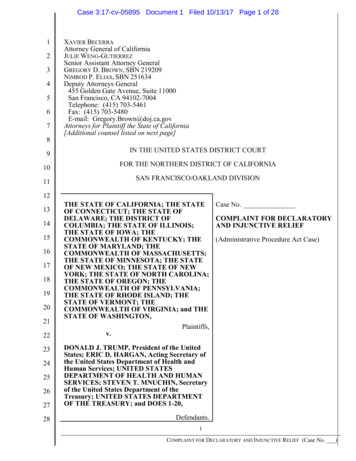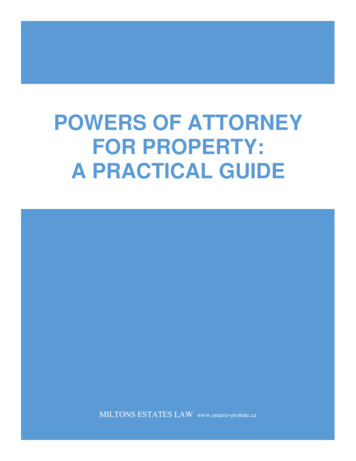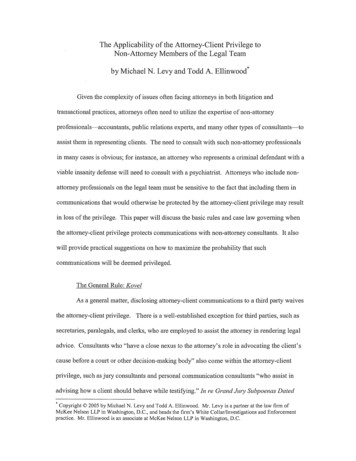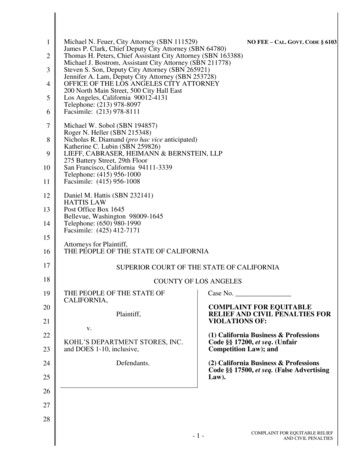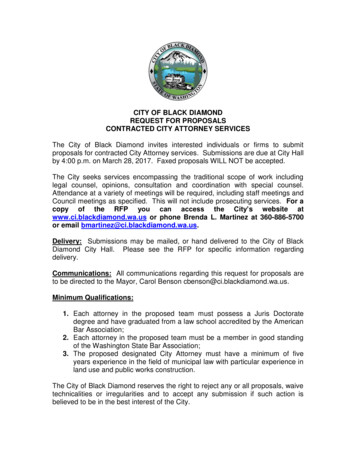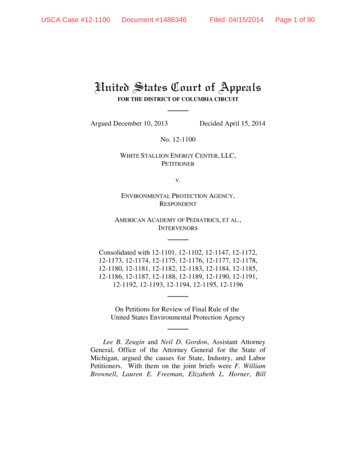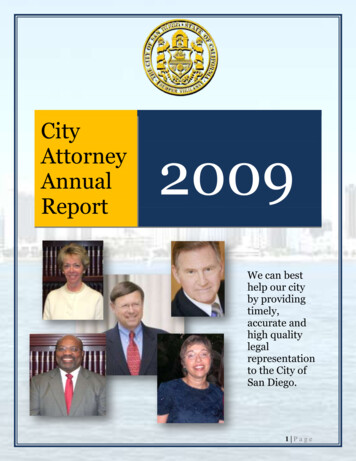
Transcription
CityAttorneyAnnualReport2009We can besthelp our cityby providingtimely,accurate andhigh qualitylegalrepresentationto the City ofSan Diego.1 Page
―I appreciate the opportunity tohave served as City Attorney during the past year and ampleased to present the 2009 City Attorney’s Annual Report.Our office is making progress on our goal to become oneof the finest municipal law firms in the nation, helping ourCity through tough times and a wide variety of lingeringlegal issues.The City Attorney’s Office has developed clientcommunication and internal team support, regular trainingprograms and quality control processes patterned afterthose used at the best private law firms. Each of ourdivisions has instituted changes that implement standardsof excellence and provide an exemplary model of qualitylegal services that I am proud of. We have communicatedand collaborated effectively and efficiently with the Mayor,City Council and all City Departments. We eliminated amid-year deficit while continuing to create ways to save thegeneral fund money.We will continue to retain our focus on quality controland maintain a level of elevation for improvementthroughout 2010 while researching additional plans toreduce unnecessary expenditures.‖City Attorney Jan Goldsmith2 Page
Table of ContentsI.CRIMINAL DIVISION:CASE ISSUANCE UNIT .7GENERAL TRIAL UNIT. 18DOMESTIC VIOLENCE UNIT . 24APPELLATE UNIT . 29II.COMMUNITY JUSTICE DIVISION:NEIGHBORHOOD PROSECUTION UNIT (NPU) . 31CONSUMER & ENVIRONMENTAL PROTECTION UNIT . 35CODE ENFORCEMENT UNIT . 38III.CIVIL LITIGATION DIVISION:CIVIL PROSECUTION UNIT . 45GENERAL LITIGATION UNIT . 46WORKERS’ COMPENSATION UNIT. 48SPECIAL LITIGATION UNIT . 49LAND USE LITIGATION UNIT . 53IV.CIVIL ADVISORY DIVISION:GOVERNMENT AFFAIRS SECTION. 543 Page
PUBLIC FINANCE, SECURITIES & DISCLOSURE SECTION . 55REAL PROPERTY & ECONOMIC DEVELOPMENT SECTION . 57PUBLIC SAFETY SECTION . 61LABOR & EMPLOYMENT UNIT . 63PUBLIC WORKS UNIT . 664 Page
The San Diego City Attorney’s Office is among the region’s largest law firms, with320 employees, including 137 attorneys handling a diverse case load. The CityAttorney’s Office advises the City and all its departments, defends the City in court andprosecutes over 40,000 criminal cases. We have restructured the office into a privatelaw firm model with four divisions: Advisory, Civil Litigation, Criminal and CommunityJustice. These divisions are subdivided into sections and units which allow ourattorneys to specialize in areas of practice.The City Attorney’s Office is built upon the senior partner, junior partner and associatemodel used in private law firms. There are five senior partners who have over133 combined years of experience as attorneys, averaging over 26years each.City Attorney Jan Goldsmith has been an attorney since 1976specializing in business litigation. He was appointed San DiegoSuperior Court Judge in 1998 and retired in December of 2008 toassume the office of San Diego City Attorney. Mr. Goldsmith spent hisfirst 6 years on the Bench handling criminal and civil trials and hisfinal years assigned to an independent civil calendar. Prior to hisappointment, Mr. Goldsmith served three terms in the California State Assemblyrepresenting the Northern San Diego City District stretching from Mira Mesa to theEscondido border. During his career in the Assembly, he held various leadershippositions including Majority Floor Leader, Member of Rules Committee, Chairmanof the Banking and Finance Committee and Vice Chairman of ldsmith.shtml5 Page
Andrew Jones, Assistant City Attorney, is head of our Criminal Divisionwith over 13 years experience as a trial attorney. During his tenure in theCity Attorney's Office, he served as a Criminal Prosecutor for 2 1/2 yearsprosecuting misdemeanor violations, heading the Discovery Unit, andprosecuting abusers in domestic violence and child abuse cases. For thelast 9 1/2 years he has served as a litigator in the Civil Trial Unitpracticing in a variety of areas including Civil Rights, Torts, InverseCondemnation, Unlawful Detainers and Breach of Contract. Mr. Joneshas tried over 50 jury trials, over 100 bench trials, and innumerablehearings and other matters in both State and Federal ns/ajones.shtmlTricia Pummill, Assistant City Attorney with our Community Justice Division is acriminal prosecutor with over 26 years experience. Ms. Pummill was a DeputyCity Attorney 1983-1999, working in the Consumer and EnvironmentalProtection, Code Enforcement, Appellate, and Trial Units. She workedas a Deputy District Attorney in San Diego, from 1999-2008. She hashandled complex criminal theft cases, cases involving unlicensedcontractors, unsanitary food markets, unlicensed automobile repairfacilities, unlicensed bus companies, travel promoters, and unlicensedattorneys. In addition, she has handled false advertising and unfaircompetition civil cases. Her extensive criminal trial experience alsocovers real estate fraud and environmental protection ions/tpummill.shtmlDonald Worley, Assistant City Attorney for our Civil Litigation Divisioncame to the City Attorney’s Office first in the Land Use Litigation Unit,after over 30 years in private practice in land use, real estate andbusiness litigation. He is credited in several appellate decisions whichmark new ground in land use and subdivision regulation. In the last yearsof his practice he was outside litigation counsel for the County ofImperial, where he extended his experience to employment ns/dworley.shtmlMary Jo Lanzafame, Assistant City Attorney, is head of our CivilAdvisory Division. She has been a strong municipal attorney with over21years experience. Her primary areas of practice include the CaliforniaEnvironmental Quality Act/National Environmental Protection Act,California Coastal Act, Planning and Zoning, Subdivision Map Act,Conflict of Interest, Brown Act, Legislative drafting, Real Estate andPublic Works. Ms. Lanzafame is an Adjunct Professor at San DiegoState University and is co-author of California Land Use Practice forContinuing Education of the /mlanzafame.shtml6 Page
I. CRIMINAL DIVISIONThe City Attorney’s Office is divided into four divisions that reflect thedistinct roles that the City Attorney performs under the City Charter:The Criminal Division prosecutesmisdemeanors and infractionscommitted within City limits. TheCriminal Division is divided into fourunits: Case Issuance, General Trial,Appellate and Domestic Violence. Uponimplementation, coordination andtraining the City Attorney’s Office hastransformed into a near seamlessoperation with the District Attorney’sOffice to attack crime. Some of ourdeputies have been authorized toprosecute felonies under a new crossdeputization program and we regularlycover court appearances for each otherand consult each other about strategy inattacking organized criminal conduct.Through computer technology and withthe help of the District Attorney’s Office,the City Attorney’s Office has aprofessional case management systemthat allows for unified searchparameters, pre-defined reports,research on history and priorconvictions, and statistics on cases,agencies and divisions. The resultsspeak for themselves as justice andefficiency prevail against criminals whenthe system works together. We havealso received positive feedback fromSuperiorCourtJudges.CASE ISSUANCE UNITOverview of the Case Issuance Unit:The Case Issuance Unit operates withinthe Criminal Division of the San DiegoCity Attorney’s Office. The CaseIssuance Unit is responsible forreceiving, processing, and reviewing allcitations, arrest reports, and crimereports submitted by local lawenforcement agencies. Attorneys in theUnit review misdemeanor and infractionviolations occurring within the City ofSan Diego, the City of Poway, and theunincorporated area known as4S Ranch.7 Page
The Case Issuance Unit can file three types of charges:Felony Wobbler: this is a crime that may be prosecuted either as a misdemeanoror a felony at the election of the prosecutor. The District Attorney’s Office electsto send certain felony wobbler cases to the City Attorney’s Office for misdemeanorprosecution.Misdemeanor: a misdemeanor is a crime that is punishable by a fine and sixmonths to one year in the county jail.Infraction: an infraction is a crime punishable by a fine.Thousands of cases are received andprocessed each month. In turn,thousands of complaints are filed incourt each month. Each case isreviewed by an attorney who decideswhether charges should be filed, and ifso, what the charges should be. Ifcharges are filed, the case is preparedfor arraignment. Thus, the Unit is jointlyresponsible with the Trial Unit forensuring the proper arraignment of eachindividual charged with a violation ofstate, county, or municipal law.The Case Issuance Unit reviewshundreds of types of violations. Ourcases range from minor violations suchas open containers of alcohol andmarijuana possession to more seriousoffenses such as driving under theinfluence, identity theft, sex crimes, andweapons possession.Finally, the supervisors within the Unitare responsible for the training anddevelopment of new attorneys and staffmembers. Attorneys are trained in thelegal requirements of reviewing casesand issuing appropriate charges againstan individual. Staff members are trainedto understand office and courtprocedures used in order to correctly filea case in court. Some staff membersare also trained to work in theMisdemeanor Arraignment Court as vitalassistants to the attorneys andcourtroom personnel.Staffing of the Case Issuance Unit:The Case IssuanceUnit is under thedirection of ChiefDeputy CityAttorney MichelleGarland andsupported by ninedeputy cityattorneys.The staff members within the Unit aredivided into three distinct groups, eachtasked with a unique function and set ofresponsibilities. Although we struggledwith staff and attorney shortages duringthe final quarter of 2009, the attorneysand the staff members work diligently toproduce a quality work product.8 Page
Cooperation with Law Enforcement Agencies:The Case Issuance Unit receives casesfrom a variety of law enforcementagencies. We work closely with eachagency to ensure successfulprosecution of each viable casesubmitted to us. These agenciesinclude: San Diego Police, San DiegoCounty Sheriff, California HighwayPatrol, San Diego Harbor Police,San Diego State University Police,University of California - San DiegoPolice, San Diego Community CollegePolice, San Diego City School Police,Department of Animal Control,Department of Health Services,Department of Fish and Game,San Diego Park Rangers, San DiegoLifeguards, Metropolitan Transit District,and the Department of AlcoholicBeverage Control.Attorneys from the Case Issuance Unitwork with our partner law enforcementagencies to facilitate opencommunication, free flow of necessaryinformation and reports, and an ongoingdialogue regarding prosecution ofmisdemeanor cases. The chief deputyfrequently attends law enforcementmeetings in an effort to answerquestions and maintain consistencythroughout the law enforcementcommunity.Highlights of 2009Case Management SystemIn 2009, the Case Issuance Unit was thefirst to begin preparation for the newCriminal Case Management System.The San Diego District Attorney’s Officegraciously allowed us to purchase theircase management system. Thisimplementation will allow the twoprosecutorial agencies to moreefficiently prosecute crimes in SanDiego County. The Case ManagementSystem is a great addition to the CaseIssuance Unit. It allows for simplerstatistical analysis, faster issuing by theattorneys, and an overall moreprofessional work product. Preparationfor the new system involved a completeanalysis of our current business processand then a complete reorganization ofthat process. Attorneys and staffmembers worked tirelessly to identifychanges that needed to be made, areaswhere higher efficiency could beobtained, and subjects that wouldrequire additional training.The result was two-fold. The staffstructure and business processes werecompletely re-organized, allowing formaximum efficiency within the newCase Management System.Additionally, the attorney workload wasreorganized and each attorney wasassigned specific responsibilities withinthe Unit.Case Issuance was the first unit to ―golive‖ with the new system onNovember 2, 2009. Overall, the9 Page
transition was successful. Fullintegration into the Case ManagementSystem will be an on-going learningprocess. However, positive steps aretaken every day and we hope to becompletely integrated very soon.Expansion of JurisdictionThe year 2009 alsobrought the expansionof the CriminalDivision’s jurisdiction toinclude theunincorporated countyarea known as 4SRanch. In January2009, the San DiegoSuperior Court clarifiedthat the proper venuefor cases occurring in4S Ranch was theCentral Division. In an effort to continuethe smooth flow of cases, the San DiegoCounty District Attorney’s Office grantedpermission and authority to the CityAttorney’s Office toprosecutemisdemeanorviolations occurring inthis unincorporatedarea of San DiegoCounty.This expandedjurisdiction brings newcases and a newrelationship with theSan Diego Sheriff’sDepartment 4S Ranch substation. Welook forward to continue serving thatarea of our community.10 P a g e
Expanded Cooperation with the District Attorney’s OfficeDuring 2009, the Case Issuance Unitdeveloped a working relationship withthe Case Issuance and Extraditions Unitat the San Diego County DistrictAttorney’s Office. The chief deputy andthe division chief and assistant chief atthe District Attorney’s Office workclosely together to seamlessly transfercases to one another in the event that acase submitted to our office should beprosecuted as a felony or a casesubmitted to the District Attorney’sOffice should be prosecuted as amisdemeanor.Better communication and informationsharing, when appropriate, have greatlyimproved the timely filing of cases thatcross both offices and the more efficientadministration of justice.Additionally, implementation of the CaseManagement System allows us to worktogether with the District Attorney’sOffice on matters that impact bothoffices and law enforcement countywide.Case Issuance Statistical Information1In 2009, the Criminal Division of the CityAttorney’s Office received approximately35,739 cases that were entered into ourformer case management system. Wefiled charges in approximately 28,635 ofthose cases. 2 Between November 2, 2009and December 31, 2009, Case Issuancedeputy city attorneys reviewed anadditional 1,717 cases that were enteredinto our new case management system.Charges were filed in 1,370 of thosecases.1The following statistics have been gathered with due diligence. However, their accuracy is limited by the technicallimitations of our former case management system, and the inherent learning curve involved in moving into the newcase management system.2These statistics represent the total number of cases submitted to the Criminal Division. They include casessubmitted directly to specialized units in addition to cases submitted to the Case Issuance Unit.11 P a g e
More specifically, in 2009 wefiled:5,670 driving under the influenceof alcohol or drugs cases1,099 petty theft cases128 grand theft cases16 false impersonation (identitytheft) cases1,030 prostitution cases417 resisting arrest cases26 harassing and annoyingtelephone calls cases27 furnishing alcohol to a minorcases328 hit and run cases withproperty damage10 hit and run cases with injuryto a person19 cases for failure to register asa sex offender35 cases for indecent exposure67 cases for committing a lewdact in public.This is a sampling of some common offensesreviewed by Case Issuance. We also file weaponspossession cases, violence cases (battery,assault with a deadly weapon, brandishing aweapon), drug possession cases, suspendeddriver’s license cases, municipal code violations,and more.Case ExamplesAlthough the Case Issuance Unit issued manyimportant cases this year, two cases areparticularly notable.Harassing Telephone Calls to aHomicide DetectiveIn May of 2008, we received a case from theSan Diego Police Department alleging that thesuspect was making harassing telephone calls toa San Diego Police Department homicidedetective and his staff members. The suspectwas a witness in a murder case from 1993 thatwas investigated by the same detective. The callshad become so bothersome that the detective andhis staff members were unable to receive newvoicemails from homicide witnesses and wereunable to fully and properly perform their jobfunctions.The case was investigated and evidence wasgathered for the remainder of 2008. Weultimately charged the defendant with 58 countsof Penal Code section 653m (a), which prohibitselectronic communications containing threateningor obscene language made with the intent toharass or annoy the victim.In late December 2008, the Defendant pleadedguilty. Both the deputy city attorney who issuedthe case and the homicide detective appeared incourt for the plea. The defendant was sentencedto 300 days in county jail, and served hissentence well into 2009. He was also placed onprobation for five years and ordered to have no12 P a g e
written or electronic contact with the victims in the case.Serious Indecent Exposure CaseIn March of 2008, the San Diego PoliceDepartment began investigating a seriesof indecent exposure incidents occurringthroughout the city. It soon becameapparent that the incidents followed thesame pattern. The suspect would entera business, sit down, wait for a victim(usually an employee) to appear, andthen expose himself. In August 2008, apress release warned the communityabout this individual and his dangerousand offensive conduct. The assigneddetectives were ultimately able to linkthe cases and trace them to the samesuspect.The cases were submitted to the CityAttorney’s Office and we beganreviewing the evidence for eachincident. In January of 2009, we filed acomplaint alleging five counts of PenalCode section 314(1), indecentexposure, and six counts of Penal Codesection 647(a), lewd act in public.The Defendant pleaded guilty and wassentenced to jail time, probation, sexoffender counseling, and mostimportantly, lifetime sex-offenderregistration.Challenges for 2010During these challenging economictimes, staff shortages and increasingworkloads will be our primary hurdle.The leadership of the Case IssuanceUnit will work diligently to prioritize andmanage the misdemeanor case load toensure that justice and the needs of ourcommunity continue to be served.Additionally, we look forward to fullintegration into the new CaseManagement System in 2010. Trainingis ongoing, as well as constant review ofour business process to attain maximumefficiency.STOP DEPUTY UNIT REPORT13 P a g e
BackgroundThe San Diego Police DepartmentSTOP Team is recognized throughoutthe state as the premier lawenforcement agency in combating theproblem of suspended, revoked, andunlicensed drivers. The San DiegoTraffic Offender Program (STOP) wasestablished in 1997 when the CaliforniaOffice of Traffic Safety (OTS) awarded atwo-year 635,000 grant to the SanDiego Police Department to create andsupport a full-time unit to proactivelyenforce driver’s license laws. The policedepartment formed the STOP Team tofocus on suspended, revoked, andunlicensed drivers because they are apublic health and safety risk. The STOPTeam officers routinely conduct driver’slicense checkpoints, stings andsurveillances, and follow-upinvestigations of illegal drivers. TheSTOP Team initiates forfeitureproceedings when a vehicle is operatedby a repeat driver’s license offender whoalso meets certain statutory criteria.In the past, the STOP Team has beencomprised of one Sergeant, five motorofficers, one officer in a vehicle, onecode compliance officer, oneadministrative aide and one full-timeDeputy City Attorney. Due to budgetaryconstraints, the STOP Team, like allother units in the department is currentlyunderstaffed. Deputy City AttorneyMelissa Ables issues and prosecutesthe STOP Team misdemeanor cases,defends the police department 30-dayimpounds, litigates all forfeiture mattersand assists in related efforts of the SanDiego Police Department (ie: Red LightCamera, Traffic Court Issues, IllegalSpeed Contests and Destruction ofVehicles and/or Component PartsMissing VINs).2009 HighlightsDriver’s License OffensesStatistics show that of all driversinvolved in fatal accidents, more than 20percent are not licensed to drive.Moreover, a driver with a suspendedlicense is four times as likely to beinvolved in a fatal crash as a properlylicensed driver. The DMV estimates that75 percent of all drivers whose drivingprivilege is withdrawn continue to drive,regardless of the law. Throughout 2009,law enforcement agencies forwardedapproximately 9,5033 misdemeanorcases involving driver’s license offensesto the City Attorney’s Office forprosecution. This number includescases involving other types of charges3This number is an estimate of the cases received.Due to the City Attorney’s transition to a CaseManagement System (CMS) on November 2, 2009,the statistics for these cases have been gathered fromtwo different computer systems. Due to someclerical errors and a change in the time and manner ofentry of these cases, tracking all of the statistics forcases involving violations occurring in 2009 has beensomewhat problematic. However, it is believed thatthis number represents the minimum number of casesthat were received involving these charges during thecalendar year.14 P a g e
including but not limited to DUI cases.Of that number, approximately73 percent (or an estimated 7,002cases) were initiated by the San DiegoPolice Department, and of those casesapproximately 23 percent (or anestimated 1,6334) were issued by theSTOP deputy city attorney. This lastnumber represents an estimated20 percent decrease in the number ofcases issued by this deputy city attorneyposition from the Calendar Year 2008during which approximately 2,029 caseswere issued. It is believed that thisreduction in cases is a direct result ofthe staffing issues discussed above andfacing the San Diego Police Departmentcity-wide.STOP Team Vehicle Forfeitures andRevenue GenerationEven with the fewer number of casessubmitted and prosecuted, the STOPTeam continued to focus on problemdrivers and there was an increase in thenumber of vehicles forfeited. DuringCalendar Year 2009, the STOP Teamforfeited 237 vehicles from repeat trafficoffenders, generating approximately 55,222.505 in revenue for the city’sgeneral fund and an equal amount4Again, due to the transition to the CMS system,inherent problems in the former system and someclerical errors the accuracy of this number is limited.It is believed that this number under-estimates theactual number of cases issued by the STOP DCAduring the calendar year. However, this representsthe best estimate of the minimum number of casesthat were issued by this position involving licensingoffenses.5This number is provided by the Fiscal Operations ofSDPD and it represents the actual revenue collectedfrom the forfeitures. However, the STOP DCA hasbeen informed that we received a partial payment of 55,744.50 in proceeds from one of the towcompany’s in forfeiture sales for Calendar Years2008 and 2009 in 2010.generated for the state’s general fund.This was approximately the sameamount of revenue generated in 2008.In addition to generating revenuethrough vehicle forfeitures, the programalso generates revenue through thecollection of the Unlicensed Driver Fee(ULD) in the amount of 72.00 for everyvehicle that is impounded because itwas being operated by an unlicensed,suspended or revoked driver. InCalendar Year 2009, the City collectedapproximately 931,068.00 in ULD fees.The ULD fees are deposited into theSTOP account, and are used to pay forthe expenses of the program. Thesefunds are in addition to the NegligentImpound Fees (NIP) in the amount of 102.00 which are also collected eachtime a ULD fee is collected. The NIPfees are deposited into the City’sGeneral Fund.Impound HearingsThere are several statutes whichauthorize the City to impound vehicle forup to 30 days in specific situations. Twostatutes, Vehicle Code section 14602.6and 23109.2 are used regularly by theSan Diego Police Department. As partof the Deputy City Attorney’s duties, theDCA assigned to STOP defends theCity at the impound hearings when theregistered owner is requesting a CourtOrder for early release of the vehicle.In 2009, the number of impoundhearings increased significantly. Therewere a total of 83 impound hearingsduring the Calendar Year 2008, which is21 less than the previous year where inthere were 104 hearings requested.The majority of the vehicles, wereimpounded pursuant to Vehicle Code15 P a g e
section 14602.6 because the driver ofthe vehicle was unlicensed, suspended,or revoked. The Court upheld the 30day impound for 65 vehicles. Therewere two (2) cases in which we did notoppose the early release because thedriver obtained a valid license. In five ofthe remaining 16 cases, the Courtordered early release, but at a date laterthan the registered owner requested.DUI ForfeituresA person convicted of athird DUI within sevenyears may have his orher vehicle declared anuisance and forfeited to thestate. During 2009, there were twovehicles sold at auction and theproceeds in the amount of 5,899.Fifteen were donated to San DiegoYouth & Community Services, Mid-CityCommunities Center, to be used forcommunity-based adolescent substanceabuse treatment services as mandatedby the California Vehicle Code.Illegal Street RacingDuring 2009, the City Attorney’s Officereceived 29 cases involving illegalspeed contests, most involving―impromptu‖ races. Although thesecases had been steadily declining since2001 when our office prosecuted 290 ofthese cases, this number represents aslight increase over the last two years.Of the cases received, our office filedcharges in 23 of the cases, and of thisnumber 15 were resolved via pleaagreement and 14 of the offenders pledto misdemeanor violations.VC 10751 ForfeituresCalifornia Vehicle Code section10751(b) authorizes law enforcementofficers to take possession of anddestroy a motor vehicle when anynumber, including but not limited tothose used for registration purposes,that is affixed by the manufacturer to thevehicle or component part, has beenremoved, defaced, altered, ordestroyed. A person in possession of avehicle or parts of a vehicle missing itsVIN number can becharged with amisdemeanor underVC § 10751 or a civilaction may be broughtto have the vehicleforfeited. In June 2006,San Diego Police DetectiveTimothy Coyle approached the CityAttorney’s Office, requestingprosecution of individuals for possessionof vehicles with missing VIN numbersand to have their vehicles ordereddestroyed. Later that year, the CityAttorney’s Office began initiating civiland criminal proceedings to forfeit anddestroy vehicles in violation of thisstatute.In 2009, the City Attorney’s Officeinitiated 25 civil proceedings to forfeitand destroy vehicles in violation of thisstatute and one (1) criminal casecharging violations of this statute. Thisrepresents an approximately 44 percentincrease in these types of cases overCalendar Year 2008, in which 18 civilproceedings were initiated. Of the25 civil cases brought forth fordestruction in 2009, the Court ordered18 vehicles destroyed, two (2) of thecases were dismissed and the vehiclewas released after the vehicles owner’svoluntarily agreed to have the offendingpart removed at their own costs, three16 P a g e
(3) of the vehicles owner’s stipulated todestruction of the vehicle, and two (2)hearings are pending for February,2010.The City Attorney’s Office elected toproceed with criminal charges in onecase because it appeared that theregistered owner had significant criminalhistory involving auto theft arrests.However, during the pendency of thecase, it was determined that theDefendant’s brother had actually beenusing the Defendant’s name. Based onthis information, the criminal case wasdismissed, after an order for destructionof the vehicle was obtained. Althoughthe Defendant was given the opportunityto remove some component parts fromthe vehicle, after he learned the costs ofdoing so,
Tricia Pummill, Assistant City Attorney with our Community Justice Division is a criminal prosecutor with over 26 years experience. Ms. Pummill was a Deputy City Attorney 1983-1999, working in the Consumer and Environmental Protection, Code Enforcement, Appellate, and Trial Units. She worked as a Deputy District Attorney in San Diego, from 1999 .
